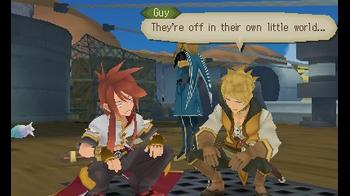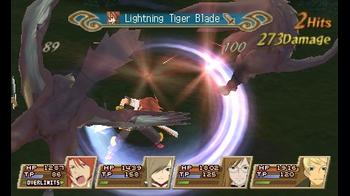
Tales of the Abyss 3DS Review
The Tales series has been on the rise over in Japan in a big way. With the latest big-screen series release out-performing Final Fantasy XIII-2 in terms of opening week sales in Japan, Namco's super-traditional RPG series has something to prove with its latest entries - though there's also a great deal of history for new fans to learn from, too.
That's likely the reasoning behind this rerelease of Tales of the Abyss for the Nintendo 3DS, bringing this 2005 PlayStation 2 release up to date and finally bringing it to Europe - the original release only made it to America.
Those of you in the US who've played Tales of the Abyss before will find little new in this title; it's better described as a port than a remake. Abyss 3D simply brings over the content from the PS2 version and makes it portable - always welcome - and obviously allows it to be played in 3D. Ports in general seem to have fared worse with that effect, with even a Nintendo-produced port like Ocarina of Time 3D having less effective 3D than Super Mario 3D Land - designed for the machine. That story remains true here, with the 3D effect in Tales of the Abyss adding little to the game and often being eye-strainingly painful to use. The precedent is set early on, as the newly created animated opening is only in 2D despite being produced for this port - 3D clearly wasn't a priority. I wholeheartedly recommend just flicking it off.
With the 3D turned off Abyss looks good - with the game at no point feeling like it's hampered by being on a handheld machine. It doesn't really look better than the PS2 version, but with this being a port it's a real victory that it doesn't look worse, with a smooth frame rate, decent-looking textures and shorter load times than the PS2 version - an advantage of the cart.
Tales is as staunchly traditional as Japanese RPGs come; owing much of its gameplay, story and design to the SNES-era RPGs that popularized the genre. From its fiery-haired protagonist Luke to the way its combat system eagerly mixes real-time and turn-based concepts to make for action-packed and exciting combat, everything drips with that niche charm that series' like Final Fantasy left in the late 90s, chasing after larger audiences.
Luke's got amnesia, of course, and the game opens with him as a sheltered young man who has barely left his family home - but the opening of the game sees him quickly catapulted from that safety into a continent-crossing adventure to save the world. It's all reassuringly familiar, but once the story settles you in with a barrage of clichés it's quick to mix things up and take some turns that'll likely leave you surprised.
Better still, Abyss' story is backed up with a cast of characters who stand out as individuals. Each character is fully-voiced, tons of dialogue squeezed onto the 3DS cartridge, and there are some genuinely likeable characters in the mix that help to give the story and the world colour. When characters are kicking out rather boring exposition about the world's over-complicated lore it's how they're acted and written that will keep things interesting, and whilst many of the characters may appear at first to merely be traditional JRPG stereotypes the cliché resemblance is often only skin deep. As the game progresses, those characters reveal elements about themselves that differentiate them from the traditional tropes in some fun and interesting ways.
A good deal of the solid character development is owed to skits, a long-standing part of the Tales series. These are essentially optional mini cutscenes that serve only to add depth to the cast of the game. These sometimes go a little too far, and unlike proper story scenes are not voiced - but they're still a great way to get to know the game's cast better - and they move this incidental dialogue out of the main story for those who don't want to experience it at all.
Combat sees you taking control of Luke alone from a side on perspective whilst your allies are controlled by the computer. Three of the face buttons are dedicated to commands for Attack, Block and to use a special Skill and what action is performed within those categories can be adjusted by the analogue stick mid-battle. There are no traditional JRPG menus to scroll through, and this is where Abyss pulls away from the SNES-era traditions that the rest of the game is slavishly devoted to.
As the game progresses you'll obtain the ability to move around the battlefield of your own free will, and this and other skills that you unlock give this battle system a feel that couldn't be further removed from other traditional Japanese RPGs on the market. If there's an issue with how battles play out it's that the real-time nature encourages you to button bash like a mad-man rather than actually be skilful, and no matter how many special skills the game throws at you button bashing remains a viable tactic right through to the back-end of the game.
The special attacks, known as 'artes' - and yes, that is the spelling - are earned as you level up and attached to different stick movements, as mentioned earlier. Artes can later be upgraded with the use of gems to change how they perform in battle, and new Artes will be unlocked for each character as you progress through the game.
Progression is also handled through 'Capacity Cores,' which can be equipped to your character and have a notable effect on how their statistics change upon level up - meaning you'll want to think carefully about your choice of Core for all members of the cast to build a strong party who'll be effective in combat. Shops are full of equipment to buy and upgrade with and there's even a synthesis system in place, too.
One worrying aspect of the last few paragraphs is the idea of AI controlled allies - often a recipe for disaster. In Tales of the Abyss, though, the AI is surprisingly competent - especially considering it was created in 2005. They'll attack, heal and defend as they see fit, whilst the player can have some agency over their actions via menu options that let you choose how you'd like them to behave in a general sense.
Battling is different, then, but levelling up itself and character progression is all very familiar to fans of the genre. It's a good thing, too, as Abyss seems to assume a lot of prior knowledge from the player - and often fails to properly explain its gameplay systems - leading players to button bash because they don't know any better. In that sense, Abyss provides a vicious circle which only the player can break out of by digging deep into the game's menus.
Tales of the Abyss marks the first truly major 'proper' RPG release for the Nintendo 3DS, and whilst this is a very basic and bare-bones port of a PS2 title this sets the system's RPG library off on a good footing.
Tales of the Abyss wasn't perfect back in 2005 and it's even less so now when compared to some modern gameplay titles, but it's still a fine game with charm, wit and unique ideas that make it stand out aesthetically - even if in other areas it's aged less gracefully.


